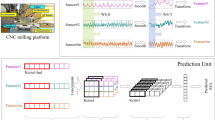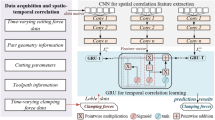Abstract
Deformation prediction is the basis of deformation control in manufacturing process planning. This paper presents an on-line part deformation prediction method using a deep learning model during numerical control machining process, which is different from traditional methods based on finite element simulation of stress release prior to the actual machining process. A fourth-order tensor model is proposed to represent the continuous part geometric information, process information, and monitoring information, which is used as the input to the deep learning model. A deep learning framework with a conventional neural network and a recurrent neural network has been constructed and trained by monitored deformation data and process information associated with interim part geometric information. The proposed method can be generalised for different parts with certain similarities and has the potential to provide a reference for an adaptive machining control strategy for reducing part deformation. The proposed method was validated by actual machining experiments, and the results show that the prediction accuracy has been improved compared with existing methods. Furthermore, this paper shifts the difficult problem of residual stress measurement and off-line deformation prediction to the solution of on-line deformation prediction based on deformation monitoring data.










Similar content being viewed by others
References
Abellan-Nebot, J. V., & Subirón, F. R. (2010). A review of machining monitoring systems based on artificial intelligence process models. International Journal of Advanced Manufacturing Technology,47(1–4), 237–257.
Arrazola, P. J., Özel, T., Umbrello, D., Davies, M., & Jawahir, I. S. (2013). Recent advances in modelling of metal machining processes. CIRP Annals—Manufacturing Technology,62(2), 695–718.
Chantzis, D., Van-Der-Veen, S., Zettler, J., & Sim, W. M. (2013). An industrial workflow to minimise part distortion for machining of large monolithic components in aerospace industry. In 14th CIRP conference on modeling of machining operations (CIRP CMMO) (Vol. 8, pp. 281–286).
Cheng, Q., Zhao, H., Zhao, Y., Sun, B., & Gu, P. (2018). Machining accuracy reliability analysis of multi-axis machine tool based on Monte Carlo simulation. Journal of Intelligent Manufacturing,29(1), 191–209.
Fu, Y., Zhang, Y., Qiao, H., Li, D., Zhou, H., & Leopold, J. (2015). Analysis of feature extracting ability for cutting state monitoring using deep belief networks. Procedia CIRP,31, 29–34.
Guiassa, R., & Mayer, J. R. R. (2011). Predictive compliance based model for compensation in multi-pass milling by on-machine probing. CIRP Annals—Manufacturing Technology,60(1), 391–394.
Gulpak, M., Sölter, J., & Brinksmeier, E. (2013). Prediction of shape deviations in face milling of steel. Procedia CIRP,8, 15–20.
Guo, H., Zuo, D. W., Wu, H. B., Xu, F., & Tong, G. Q. (2009). Prediction on milling distortion for aero-multi-frame parts. Materials Science and Engineering A—Structural Materials Properties Microstructure and Processing,499(1–2), 230–233.
Hao, X., Li, Y., Chen, G., & Liu, C. (2018). 6 + X locating principle based on dynamic mass centers of structural parts machined by responsive fixtures. International Journal of Machine Tools and Manufacture,125, 112–122.
He, K., Zhang, X., Ren, S., & Sun, J. (2016). Deep residual learning for image recognition. In 2016 IEEE conference on computer vision and pattern recognition (CVPR), Las Vegas, NV (pp. 770–778).
Heinzel, C., Sölter, J., Gulpak, M., & Riemer, O. (2017). An analytical multilayer source stress approach for the modelling of material modifications in machining. CIRP Annals—Manufacturing Technology,66(1), 531–534.
Huang, X. M., Sun, J., & Li, J. F. (2015). Finite element simulation and experimental investigation on the residual stress-related monolithic component deformation. International Journal of Advanced Manufacturing Technology,77(5–8), 1035–1041.
Kolda, T. G., & Bader, B. W. (2009). Tensor decompositions and applications. SIAM Review,51(3), 455–500.
Lecun, Y., Bengio, Y., & Hinton, G. (2015). Deep learning. Nature,521(7553), 436–444.
Li, J. G., & Wang, S. Q. (2017). Distortion caused by residual stresses in machining aeronautical aluminum alloy parts: Recent advances. International Journal of Advanced Manufacturing Technology,89(1–4), 997–1012.
Li, Y., Liu, C., Hao, X., Gao, J. X., & Maropoulos, P. G. (2015). Responsive fixture design using dynamic product inspection and monitoring technologies for the precision machining of large-scale aerospace parts. CIRP Annals—Manufacturing Technology,64(1), 173–176.
Li, Y., Liu, X., Gao, J. X., & Maropoulos, P. G. (2012). A dynamic feature information model for integrated manufacturing planning and optimization. CIRP Annals—Manufacturing Technology,61(1), 167–170.
Lin, H., Li, B., Wang, X., Shu, Y., & Niu, S. (2018). Automated defect inspection of LED chip using deep convolutional neural network. Journal of Intelligent Manufacturing. https://doi.org/10.1007/s10845-018-1415-x.
Moehring, H. C., Wiederkehr, P., Gonzalo, O., & Kolar, P. (2018). Intelligent fixtures for the manufacturing of low rigidity components. Berlin: Springer.
Möhring, H. C., Litwinski, K. M., & Gümmer, O. (2010). Process monitoring with sensory machine tool components. CIRP Annals—Manufacturing Technology,59(1), 383–386.
Nervi, S., Szabó, B. A., & Young, K. A. (2009). Prediction of distortion of airframe components made from aluminum plates. AIAA Journal,47(7), 1635–1641.
Pimenov, D. Y., Bustillo, A., & Mikolajczyk, T. (2017). Artificial intelligence for automatic prediction of required surface roughness by monitoring wear on face mill teeth. Journal of Intelligent Manufacturing,29(1), 1–17.
Pratama, M., Dimla, E., Lai, C. Y., & Lughofer, E. (2017). Metacognitive learning approach for online tool condition monitoring. Journal of Intelligent Manufacturing. https://doi.org/10.1007/s10845-017-1348-9.
Shang, M. E. H. (1995). Prediction of the dimensional instability resulting from machining of residually stressed components. Lubbock: Texas Tech University.
Silver, D., Huang, A., Maddison, C. J., Guez, A., Sifre, L., Driessche, G. V. D., et al. (2016). Mastering the game of Go with deep neural networks and tree search. Nature,529(7587), 484.
Tang, Z. T., Yu, T., Xu, L. Q., & Liu, Z. Q. (2013). Machining deformation prediction for frame components considering multifactor coupling effects. International Journal of Advanced Manufacturing Technology,68(1–4), 187–196.
Wang, J., Ma, Y., Zhang, L., Gao, R. X., & Wu, D. (2018a). Deep learning for smart manufacturing: Methods and applications. Journal of Manufacturing Systems,48(C), 144–156.
Wang, P., Gao, R. X., & Yan, R. (2017a). A deep learning-based approach to material removal rate prediction in polishing. CIRP Annals—Manufacturing Technology,66(1), 429–432.
Wang, P. S., Liu, Y., Guo, Y. X., Sun, C. Y., & Tong, X. (2017b). O-CNN: Octree-based convolutional neural networks for 3D shape analysis. ACM Transactions on Graphics,36(4), 1–11.
Wang, T., Qiao, M., Zhang, M., Yang, Y., & Snoussi, H. (2018b). Data-driven prognostic method based on self-supervised learning approaches for fault detection. Journal of Intelligent Manufacturing,3, 1–9.
Wang, X., Bi, Q., Zhu, L., & Ding, H. (2018c). Improved forecasting compensatory control to guarantee the remaining wall thickness for pocket milling of a large thin-walled part. International Journal of Advanced Manufacturing Technology,94(5–8), 1–12.
Wu, Q., Ding, K., & Huang, B. (2018). Approach for fault prognosis using recurrent neural network. Journal of Intelligent Manufacturing. https://doi.org/10.1007/s10845-018-1428-5.
Wu, Q., Li, D. P., Ren, L., & Mo, S. (2016). Detecting milling deformation in 7075 aluminum alloy thin-walled plates using finite difference method. International Journal of Advanced Manufacturing Technology,85(5–8), 1291–1302.
Yoshioka, H., Shinno, H., Sawano, H., & Tanigawa, R. (2014). Monitoring of distance between diamond tool edge and workpiece surface in ultraprecision cutting using evanescent light. CIRP Annals—Manufacturing Technology,63(1), 341–344.
Yu, J. (2017). Adaptive hidden Markov model-based online learning framework for bearing faulty detection and performance degradation monitoring. Mechanical Systems and Signal Processing,83, 149–162.
Acknowledgements
The reported research was funded by the National Natural Science Foundation of China (Ref. 51775278), the National Natural Science Foundation of China—Chinese Aerospace Science and Technology Corporation on Advanced Manufacturing (Ref. U1537209), and the Jiangsu Province Outstanding Youth Fund (Ref. BK20140036).
Author information
Authors and Affiliations
Corresponding author
Additional information
Publisher's Note
Springer Nature remains neutral with regard to jurisdictional claims in published maps and institutional affiliations.
Rights and permissions
About this article
Cite this article
Zhao, Z., Li, Y., Liu, C. et al. On-line part deformation prediction based on deep learning. J Intell Manuf 31, 561–574 (2020). https://doi.org/10.1007/s10845-019-01465-0
Received:
Accepted:
Published:
Issue Date:
DOI: https://doi.org/10.1007/s10845-019-01465-0




